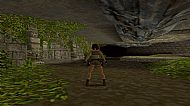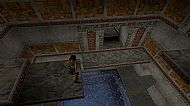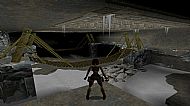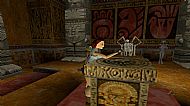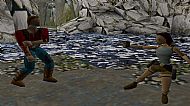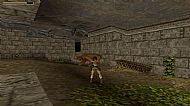Tomb Raider 1
Release Date: November 1996
Platforms: PC, PlayStation and Sega Saturn
Synopsis: "Adventurer Lara Croft has been hired to recover the pieces of an ancient artefact known as the Scion. With her fearless acrobatic style, she runs, jumps, swims and climbs her way toward the truth of its origins and powers - leaving only a trail of empty tombs and gun-cartridges in her wake. On this trail are the most breath-taking 3D worlds yet seen - where exploration, puzzle and platform elements blend in a seamless real-time environment."
In Tomb Raider, the player controls the female archaeologist Lara Croft, in search for the three mysterious Scion artefacts across the world. The game is presented in third person perspective. Lara is always visible and the camera follows the action from behind or over her shoulder. The world she inhabits is fully drawn in three dimensions and characterised by its cubic nature. Ledges, walls and ceilings mostly sit at 90 degrees to each other, but sometimes feature sloping planes.
The object of Tomb Raider is to guide Lara through a series of tombs and other locations in search of treasures and artefacts. On the way, she must kill dangerous animals and other creatures, while collecting objects and solving puzzles to gain access to an ultimate prize, usually a powerful artefact. Gunplay is restricted to the killing of various animals that appear throughout each stage, although occasionally Lara may be faced with a human opponent. Instead the emphasis lies on solving puzzles and performing trick jumps to complete each level. As such, Tomb Raider in essence harkens back to the classical form of platform style gameplay
Features:
Movement in the game is varied and allows for complex interactions with the environment. Besides walking, running, and jumping, Lara can perform side-steps, hang on ledges, roll over, dive, and swim through water. In a free environment, Lara has two basic stances: one with weapons drawn and one with her hands free. By default she carries two pistols with infinite ammo. Additional weapons include the shotgun, dual magnums and dual Uzis. At a certain point in the story, Lara will be stripped of all her weapons, leaving the player defenseless and forced to recover her pistols, a development which later became a staple of the series. Numerous enemies as well as a variety of lethal traps can bring about Lara's death in Tomb Raider, the most important threat of which is falling to death. As the game adopts a platform style approach of progress, well timed jumps must often bring Lara safely to the other side of a ledge or she will plummet to the ground below. Other means by which the game will prematurely end include death by burning, drowning, electrocution, becoming impaled on spikes, killed by human enemies, or creatures and even being turned into gold by the hand of Midas.
A general action button is used to perform a wide range of movements in Tomb Raider, such as picking up items, pulling switches, firing guns, pushing or pulling blocks, and grabbing onto ledges. Regular items to pick up include ammo, and small and large medi-packs. Game-specific items are keys and artefacts required to complete a stage. Any item that is collected is held onto in Lara's inventory until it is used. The puzzles that the player encounters across each level vary: pulling specific combinations of levers, a course of timed jumps, avoiding a certain trap or collecting several keystones. Throughout each stage, one or more secrets may be located. Discovering these secrets is optional, and when the player has found one a tune plays. The locations of these secrets vary in difficulty to reach. Some are hidden along the roadside in bushes, others require the completion of a hidden course or optional puzzle to be found. The player is usually rewarded with extra items.
In the PlayStation and Sega Saturn versions of Tomb Raider, saving the game is restricted to fixed save points within each level, marked by a floating blue crystal or by completing the level. When Lara touches one of these the option to save is made available. The scarcity of these points, however, means that if the player dies, large portions of each level must be replayed. Following criticism on this system, Core implemented a save anywhere at any time feature in Tomb Raider II. The DOS version of the game allow the player to save at any time. A stage is finished when a certain doorway is reached, an artefact is recovered, or a boss is destroyed.
Tomb Raider: Unfinished Business and Tomb Raider Gold:
In 1998, shortly after the release of Tomb Raider II, Tomb Raider was re-released. This release, titled Tomb Raider Gold - The Shadow Of The Cat in North America, and Tomb Raider: Unfinished Business elsewhere, featured the regular game as well as two new expert chapters ("Shadow of the Cat" and "Unfinished Business") in four levels, two levels each. The levels for Tomb Raider Gold were created in the San Francisco office of Eidos by Phil Campbell, Rebecca Shearin, and Gary LaRochelle.
The first chapter of the game takes place in Egypt, and occurs several months after the events of Tomb Raider. The story sees Lara returning to the City of Khamoon to investigate a mysterious statue of the Egyptian goddess Bast. This leads to her discovery of an entirely new temple dedicated to the cat deity, which includes a giant gold statue several stories high. The second chapter takes place before those of the first chapter—quite literally straight after the events of Tomb Raider. This chapter starts with Lara sliding down the same slope as in Tomb Raider's final level, and finishes with her destroying the last remnants of the Atlantean Race.
Shadow of the Cat features two levels: "Return to Egypt" and "Temple of the Cat". Unfinished Business features two other levels, called: "Atlantean Stronghold" and "The Hive".
Cheat Codes PS1
Press select to go to the inventory then enter the following,
All Weapons - L1, Triangle, R2, L2, L2, R2, Circle, L1
Stage Skip - L2, R2, L1, Circle, Triangle, L1, R2, L2
For Pal Players:
All Weapons - L1, Triangle, L2, R2*2, L2, O, L1
Level Skip - L2, R2, Triangle, L1*2, O, R2, L2
Reception:
Tomb Raider remains the most critically acclaimed game in the long-running franchise, and has sold over 7 million copies worldwide becoming a bestseller. Upon its release in 1996, the game was widely praised by gaming magazines for its revolutionary graphics, inventive gameplay, and involving storyline.Game Informer ranked it the 86th best game ever made in 2001. They praised it for Lara's appeal to gamers and non-gamers alike.The level of sophistication Tomb Raider reached by combining state-of-the-art graphics, an atmospheric soundtrack, and a cinematic approach to gameplay was at the time unprecedented.The resulting sales were consequential, topping the British charts a record three times,and contributing much to the success of the PlayStation.In the previous year, Eidos Interactive had recorded a nearly $2.6 million in pre-tax loss. The success of the game turned this loss into a $14.5 million profit in only a year.
As one of the top selling games of the PlayStation console, it was one of the first to be released on PlayStation's Platinum series, and its success made Tomb Raider II the most anticipated game of 1997. It also won a multitude of Game of the Year awards from leading industry publications. In 1998, Tomb Raiderwon the Origins Award for Best Action Computer Game of 1997. The Lara Croft character was prominently featured in the popular media outside the realm of video gaming, for instance on the cover of cutting-edge pop culture magazine The Face in June 1997. In the final issue of the Official UK PlayStation Magazine, the game was chosen as the 4th best game of all time. Tomb Raider, along with its successor, Tomb Raider II, are the two best selling games in the franchise.
Nevertheless, Tomb Raider received some criticism for minor camera and object glitches,as well as its save system. Additionally, some fans complained about the lack of action in the game, in favor of puzzle solving. Although ironically, Tomb Raider II would be criticized for its overabundance of violence, especially against human opponents.

